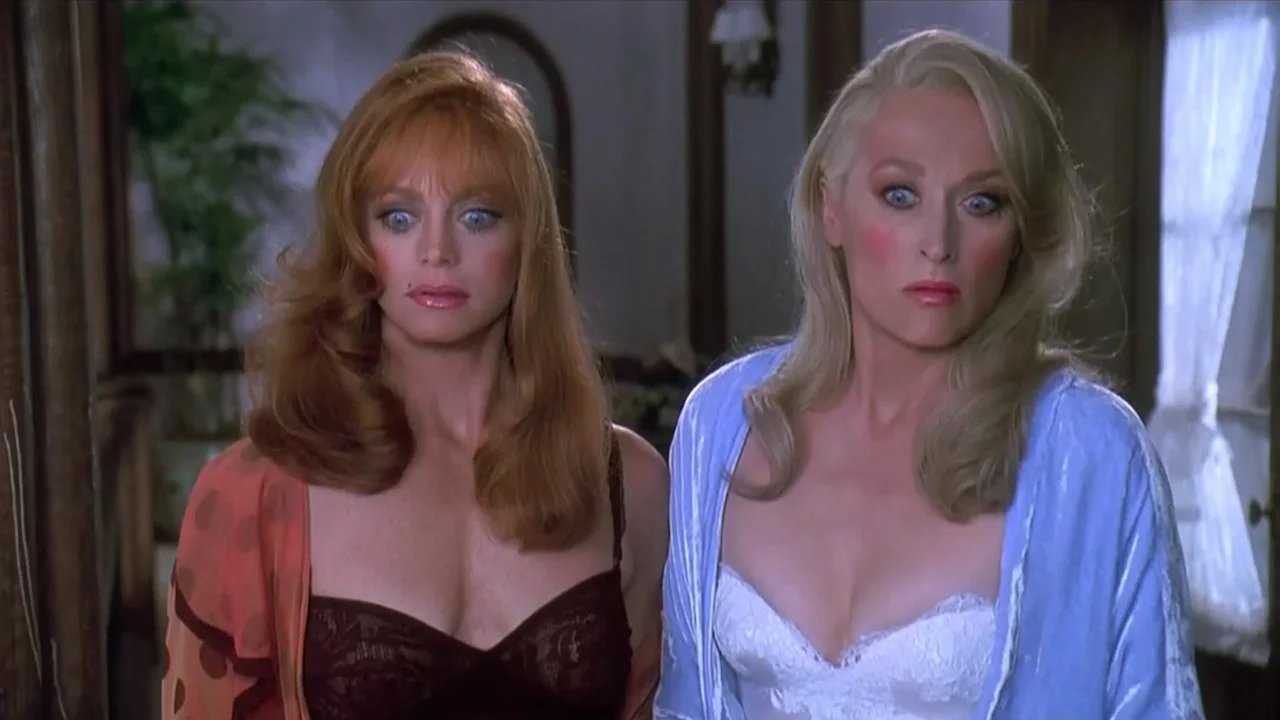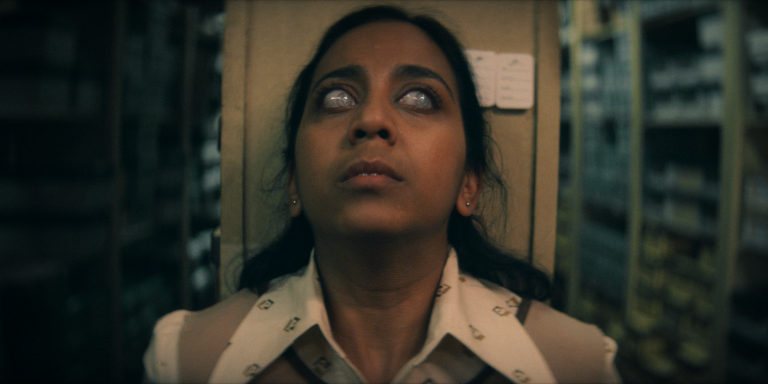We open with an epicenter of American celebrity, which uses a piece of classic iconography to introduce our female protagonist as a true star. However, that iconography soon falls apart, representing their decline into the realm of the has-been. What I have described is not the start of Coralie Fargeat’s new film “The Substance,” in which Elizabeth Sparkle’s (Demi Moore) star on the Hollywood Walk of Fame fades and cracks. Instead, I am referring to the opening of Robert Zemeckis’ “Death Becomes Her,” where a downward pan reveals disappointed audiences walking out of Madeline Ashton’s (Meryl Streep) new Broadway show before we see her Playbill cover sodden in a puddle.
Although Fargeat does not directly quote Zemeckis’ camp classic, opting instead to pay homage to films like “The Shining” and “Carrie,” the parallels between the two are clear. Both films feature a formerly celebrated star who has slipped from the limelight and, despite being played by a gorgeous actress, is facing their own obsolescence. This leads them to an elusive substance, or potion, which allows them to once more dabble in their youth. In “Death Becomes Her,” it reverses the aging process and perks everything up again, while in “The Substance” it births a fresh-faced doppelgänger for them to live through vicariously.
Furthermore, both women also feel threatened by, and end up violently confronting, a nubile counterpart whose physical perfection accentuates their own perceived flaws. In the case of Elizabeth Sparkle, it is Sue (Margaret Qualley), the younger version of herself The Substance produces. For Madeline Ashton, it is Helen Sharp (Goldie Hawn), the former frenemy whose fiancée Ernest Melville (Bruce Willis) she stole and who now looks more radiant than ever (in a mild spoiler, it emerges she took the potion long before Madeline did).
However, despite their similarities, the film’s journeys to and from the screen could not be more different. “The Substance” was modestly budgeted and has opened to the buzzy mix of adulation and outrage likely to earn its cult status. On the other hand, although writers David Koepp and Martin Donovan had envisioned “Death Becomes Her” as a low-budget B-movie, their screenplay caught the eye of Back to the Future’s Robert Zemeckis, who morphed it into a $55 million special-effects-driven tentpole spectacular. Unfortunately, its eccentric tone was not suited for mainstream audiences, and it fizzled out with only $59 million at the North American box office.

The critical response was no better as the New York Times called it both ‘surprisingly tame’ and ‘wildly uneven,’ while New York Magazine wrote that ‘Anxiety, loathing, and self-hatred gush from its gaudy pores.’ They even went as far as to call the film ‘too loud and desperate to achieve camp.’ However, over time, it seems audiences have succumbed to the film’s gaudy charms. It has become a favorite in the queer community, and this summer it was remade as a Broadway musical. It also inspired Sabrina Carpenter’s “Taste” music video (an edit has even replaced them with Hawn and Streep), and Adele dressed as Madeline for Halloween when Meryl Streep attended her Las Vegas show. The film has also garnered praise for how it tackles the beauty and cosmetic industries.
Danielle Freedman wrote on the film’s 25th anniversary that it is ‘more relevant now than ever’ as a ‘PSA against trying to turn back the clock on our bodies.’ This reappraisal becomes more compelling considering the spate of negative reactions “The Substance” has received for its treatment of the female form. Hannah Strong argued in Little White Lies the film is ‘just more hagsploitation,’’ while Kevin Maher in The Times wrote ‘It is puerile, pointless and intellectually specious’ in its attempts ‘to justify endless seedy close-ups of Qualley’s bum’.
“The Substance” is a film that aims to provoke its audience above all else, and it certainly makes for a raucous ride. However, its imagery also oscillates between such extremes of grotesqueness and fetishization that it recreates the very stereotypes it aims to critique. As Strong writes, the film ‘replicates the history of horror’s exploitation of women’s bodies rather than subverts it.’ Fargeat overwhelms her film with such a deluge of provocative imagery that it clouds out any potential critical themes it may possess. While “The Substance” may be jolly good fun, it is a film that leaves the brain feeling dizzied rather than pensive.
In contrast, the silly, good-natured eccentricity that has cemented Death Becomes Her’s lasting appeal has also helped it to become a convivial, yet pertinent, parable on accepting the aging process. While New York Magazine may have believed the film was ‘contemptuous of itself,’ this could not be further from the truth as Zemeckis takes pleasure in its arch narrative and affectatious characters. In the same way, Fargeat cites her body-horror icons, Zemeckis has fun harkening back to the hammer horror features of the 1930s as the film’s Frankestein-esque narrative develops.
It emerges that Death Becomes Her’s potion grants eternal youth by killing its recipient and turning them into a beautified walking corpse. This means that no matter what damage is inflicted on the body, it can’t die and will need to be pieced back together. This is unfortunate for Madeline and Helen, who tear literal chunks from each other during a catfight. Queue Ernest, a former plastic surgeon relegated by alcoholism to the role of a glorified mortician, utilizes his unique skillset in applying industrial-level adhesives to corpses to patch the women back to their former glory.
This conceit allows for some brilliantly naff one-liners, “The morgue she’ll be furious!”, “I can see right through you” and “Now a warning!” to name a few, which give the film its Rocky Horror level of quotability. However, it also allows the film to slip in some quietly powerful themes about the inevitability of aging and the horrific consequences of trying to stop it.

While its barbs at the Hollywood obsession with plastic surgery are certainly not complex, the film speaks to the broader folly of trying to stand against the inevitable forces of nature. “Screw the natural law!” booms Lisle Von Rhuman (Isabella Rossellini), the shadowy mistress who provides Madeline with the potion. This question of nature comes up time and again as the film positions its quest for youth not as an internecine battle of woman against woman, as it appears in “The Substance,” but as an unwinnable confrontation with the elements themselves. While Elizabeth and Sue fight each other into oblivion, Madeline and Helen eventually reconcile, only to be ruined by the cruelty of time. The brilliant casting of Rossellini, who at the time held a modeling contract for an anti-aging cream, helps to drive this all home even better.
It is a more nuanced message than the film’s lunacy first makes it seem, and its delivery within such a theatrical narrative also makes it easier to digest. On the one hand, “The Substance” is an utter assault on the senses akin to the unmediated stream of unattainable perfection and doom-mongering fed to us through our social media feeds. It is striking and visceral, but its images linger far more than its ideas. On the other hand, Death Becomes Her’s slapstick charms disarm the senses, allowing the film to gently coax its message into the minds of its audience.
These differences extend to both films’ depictions of aging and the “ideal” female body. In “The Substance,” the camera leers obsessively over Margaret Qualley’s Sue as she thrusts her spandex-coated body, and Elizabeth’s accelerated aging is depicted as an unnatural monstrosity. Meanwhile, the artificiality of Madeline’s transformation into the “perfect” woman is playfully exaggerated as her body puffs up like an airbag.
Furthermore, her and Helen’s descent from beauty occurs not because of their aging but because of the plastic guises they use to hide it. Their thick layers of industrial cosmetics begin cracking and tearing until they resemble a pair of poorly made-up drag acts. In contrast to “The Substance,” the female body is not the site of decline and mockery but rather the unholy veneer of silicon and artificial collagens plastered over it. “Death Becomes Her” aims not at its female leads but rather at the cocktail of paraphernalia sold to them to retain their youth.
Both “The Substance” and “Death Becomes Her” are enjoyable films that combine similar premises with brazen storytelling and twisted visual effects to craft a good old time at the cinema. However, the schlocky campiness of “Death Becomes Her,” which stands out against The Substance’s excessive provocation, makes it the far more relevant of the two today.







